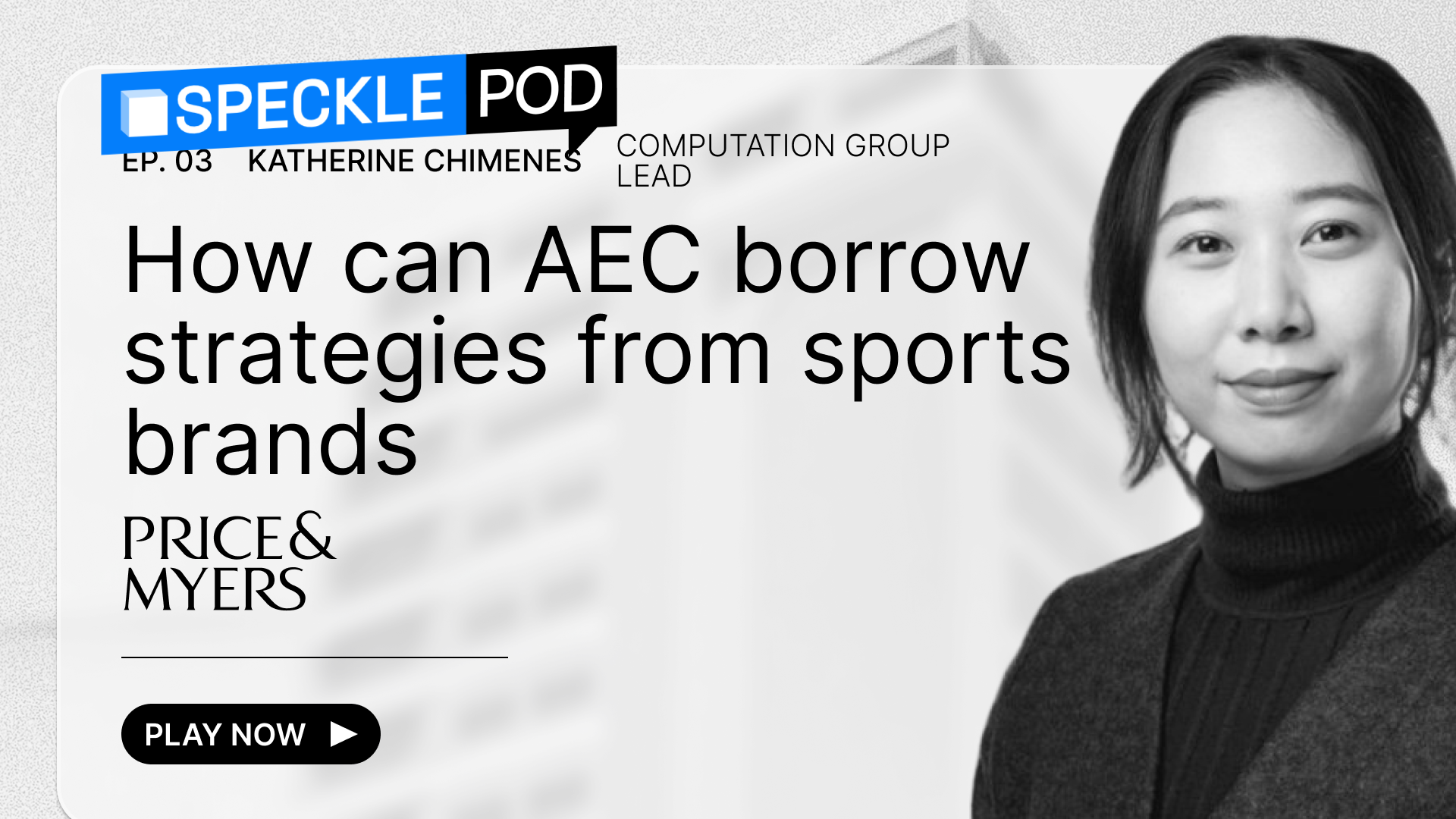
SpecklePod: Katherine Chimenes knows what AEC is missing to thrive
Welcome to SpecklePod, the only podcast focused on breaking free in the AEC industry!
In this episode, we sat down with Katherine Chimenes, Structural Engineer and Computation Group Lead at Price & Myers. She’s redefining the boundaries of engineering through her passion for technology, sustainability, with an iconic tell-it-like-it-is and there-has-to-be-a-better-way approach.
This article is just an overview for this very interesting podcast episode: we wholeheartedly recommend you still listen to it!
Katherine’s Journey: From Coding to Structural Engineering
Katherine’s career is a testament to adaptability and growth. Initially drawn to computer science, she pursued a degree at Imperial College London, where she discovered her love for creating tangible impact is greater than her love for coding. Well, it’s actually more complicated than that, but let’s take it step by step.
A very life pivoting internship at Arup introduced her to the world of structural engineering, and she hasn’t looked back since.
Her journey highlights the importance of:
- Adaptability: Transitioning from coding to engineering, Katherine embraced new challenges and opportunities even when all anyone would want to is to give up.
- Mentorship: Early mentors at Arup recognized her unique skill set and encouraged her to bridge the gap between technology and engineering.
- Innovation: Katherine’s current work at Price & Myers focuses on pushing the boundaries of building efficiency and sustainability, using computational tools to drive innovation. Khm, khm, Speckle, anyone?
The AEC Industry: Challenges and Opportunities
Katherine’s experience in both tech and AEC has given her a unique perspective on the industry’s challenges. She describes the AEC landscape as a “tangled web of chaos” (honestly—same!), where proprietary data structures and clunky software hinder collaboration and innovation.
Key challenges include:
- Proprietary software: Tools like Revit often lack user-centric design, creating barriers to efficient workflows.
- Lack of user research: Unlike industries such as tech or sports (Katherine had a brief gig at Nike—listen to the episode to find out more), AEC rarely prioritizes user feedback in tool development.
- Talent retention: The industry risks losing skilled professionals to adjacent fields due to limited (or no) recognition of computational skills and lack of growth opportunities.
Breaking Free: Speckle as a Catalyst for Change
Katherine’s work with Speckle exemplifies how open workflows can transform collaboration in AEC. On a recent project, she introduced Speckle to a team of architects, fabricators, and engineers, enabling seamless 3D model sharing and real-time collaboration.
The results were transformative:
- Low barrier to entry: Even team members unfamiliar with 3D software could easily access and interact with models. All hail Speckle’s awesome online 3D viewer!
- Enhanced collaboration: Speckle streamlined communication, reducing errors and improving coordination across disciplines.
- Empowering users: By focusing on user needs, Katherine demonstrated how tools like Speckle can bridge the gap between complex engineering and practical, user-friendly solutions. The actual end user is always in focus!
The Elephant in the Room: AEC’s Lack of Self-Awareness
Katherine identifies the industry’s lack of self-awareness as its biggest challenge. While there’s much talk about AI and digital transformation, many firms struggle with fundamental issues like knowledge retention, funding for innovation, and fostering a culture of collaboration.
She emphasizes the need for:
- Cultural shifts: Moving away from rigid hierarchies and embracing open workflows.
- User-centric design: Prioritizing the needs of end-users, whether they’re engineers, architects, or building occupants.
- Recognition of computational skills: Integrating digital expertise into the core skill set of structural engineers.
What Does Breaking Free in AEC Mean to Katherine?
For Katherine, breaking free means understanding what truly matters in the industry and shedding outdated practices. It’s about fostering a culture of curiosity, collaboration, and innovation, where professionals are empowered to explore new tools and methodologies.
Her advice to the industry:
- Listen to users: Whether it’s clients, engineers, or building occupants, their feedback is invaluable.
- Embrace open workflows: Tools like Speckle can unlock new levels of efficiency and creativity!
- Invest in talent: Recognize and nurture the skills of professionals who bridge the gap between engineering and technology.
Conclusion
Katherine Chimenes is a force to be reckoned with and a great example of how bold individuals can drive change in the AEC industry. By embracing innovation, prioritizing collaboration, and challenging the status quo, she is paving the way for a more open and efficient future.
Tune in to this episode of SpecklePod to hear Katherine’s full story and insights. Available on Spotify, YouTube, Apple Podcasts, and other platforms.
Disclaimer: The views and opinions expressed here do not reflect the policies or positions of Price & Myers and are strictly Katherine's. Thank you!
Subscribe to Speckle News
Your backstage pass to our product updates, community buzz, and industry know-how.





